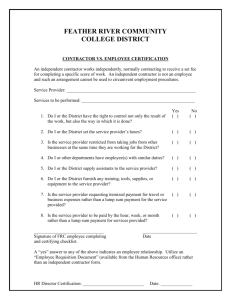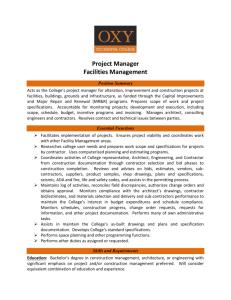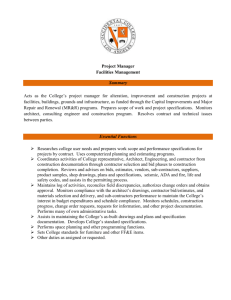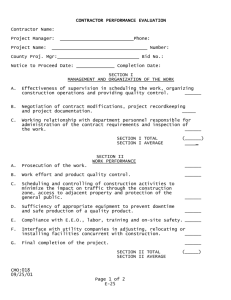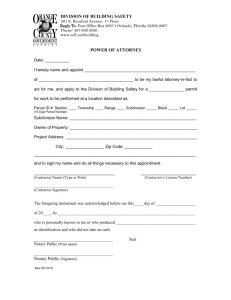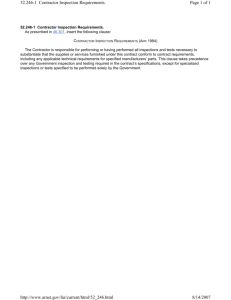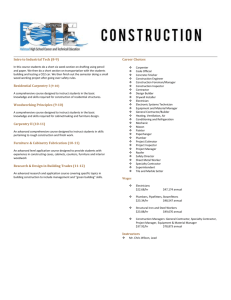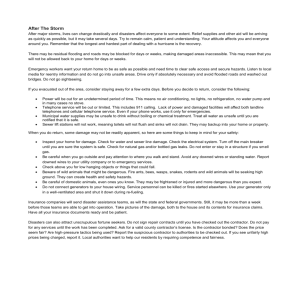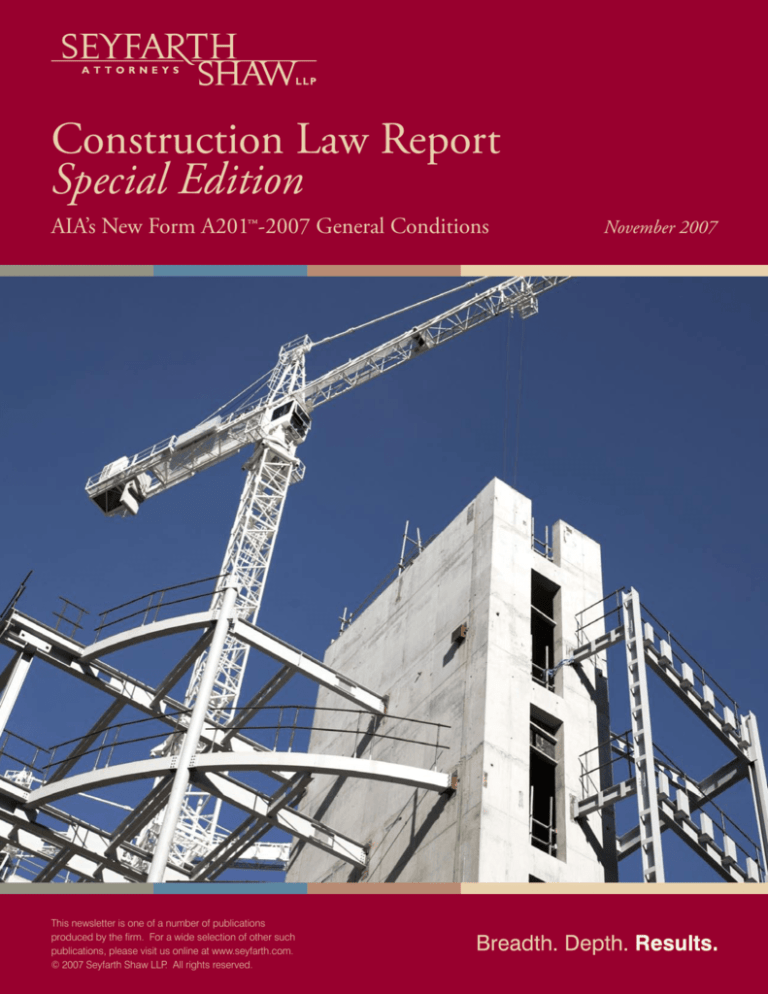
Construction Law Report
Special Edition
AIA’s New Form A201™-2007 General Conditions
This newsletter is one of a number of publications
produced by the firm. For a wide selection of other such
publications, please visit us online at www.seyfarth.com.
© 2007 Seyfarth Shaw LLP. All rights reserved.
November 2007
Construction Law Report
A Special Edition for a Special Event
On November 5, 2007, for the first time in a decade, The American Institute of Architects (“AIA”) released a revised
edition of its popular series of project forms for the construction industry, including standard form agreements between
Owner and Contractor, and Owner and Architect, and the widely utilized A201™*-1997 General Conditions of the
Contract for Construction. In doing so, AIA expressly acknowledged considerable industry concern about terms in
the A201-1997 form with respect to financial matters and dispute resolution, among other items. AIA believes that its
revised form “fairly balance(s) divergent interests, and accurately reflects(s) the modern construction industry.”
And, for the first time ever, extending over a fifty year period, the Associated General Contractors of America (“AGC”)
has declined to endorse the AIA General Conditions. In its October 9, 2007 letter to AIA explaining its decision, AGC
expressed the “grave concerns” of its membership that the 2007 edition of A201 “significantly shifts risks to General
Contractors and other parties outside of the design profession” and voices “philosophical disagreement regarding an
architect’s authoritative role and mandated linear process.”
The AIA documents come about six weeks after the publication of a competing new series of documents, under the
brand ConsensusDOCS™**, by a consortium of owner, contractor and trade groups, including The Construction Users
Roundtable, Construction Owners Association of America, Construction Industry Round Table, Associated Builders and
Contractor, Inc., Lean Construction Institute, and the National Subcontractors Alliance, among others, in addition to
AGC. This consortium touts itself as a “new voice of the industry” and claims that its new family of documents are more
innovative and collaborative. Among other things, for instance, the owner/contractor agreement for a lump sum project
and related general conditions are joined in a single, integrated document designated the ConsensusDOCS 200.
Volumes have been written about the 1997 General Conditions and, undoubtedly, volumes more will be written about
the 2007 edition. AIA has made changes to every article, some more extensively than others, and over one-hundred
(100) sections of the A201-1997 document. Our purpose here is relatively modest: to highlight some of the more
important changes in the new A201-2007 edition. We caution all readers who truly wish to understand the new General
Conditions form, and its implications, to review it fully and carefully, and to consult with counsel of their choice.
To achieve our purpose, rather than begin with those changes that we think are most important, a value judgment
that may well vary from project to project (and company to company), we have proceeded in the order of the A2012007 document itself and commented on those provisions that contain substantive revisions. We have set forth the new
language in quotations, in a neutral context, and offered commentary separately.
Roger L. Price/Mark L. Johnson
November 6, 2007
*A201 is a trademark of The American Institute of Architects.
**ConsensusDOCS is a trademark of ConsensusDOCS LLC.
Seyfarth Shaw LLP
|
Construction Law Report
Table of Contents
ARTICLE 1 GENERAL PROVISIONS
Section 1.1 Basic Definitions...................................................................................................................... 5
Section 1.1.8
Section 1.6 Transmission of Data in Digital Form................................................................................... 5
Section 1.6.1
ARTICLE 2 OWNER
Section 2.2 Information and Services Required of the Owner.............................................................. 5
Section 2.2.1
ARTICLE 3 CONTRACTOR
Section 3.1 General...................................................................................................................................... 6
Section 3.1.1
Section 3.2 Review of Contract Documents and Field Conditions by Contractor............................. 6
Section 3.2.2, Section 3.2.3, Section 3.2.4
Section 3.3 Supervision and Construction Procedures.......................................................................... 6
Section 3.3.1
Section 3.7 Permits, Fees, Notices, and Compliance with Applicable Laws....................................... 7
Section 3.7.2, Section 3.7.3, Section 3.7.4, Section 3.7.5
Section 3.8 Allowances................................................................................................................................. 8
Section 3.8.3
Section 3.9 Superintendent.......................................................................................................................... 9
Section 3.9.2, Section 3.9.3
Section 3.10 Contractor’s Construction Schedules................................................................................ 9
Section 3.10.2
Section 3.12 Shop Drawings, Product Data and Samples...................................................................... 9
Section 3.12.5, Section 3.12.6
ARTICLE 4 ARCHITECT
Section 4.1 General..................................................................................................................................... 10
Section 4.1.1
Section 4.2 Administration of the Contract............................................................................................. 10
Section 4.2.1, Section 4.2.2, Section 4.2.3, Section 4.2.7, Section 4.2.14
|
Seyfarth Shaw LLP
Construction Law Report
ARTICLE 5 SUBCONTRACTORS
Section 5.2 Award of Subcontracts and Other Contracts for Portions of the Work........................ 11
Section 5.2.1
ARTICLE 9 PAYMENTS AND COMPLETION
Section 9.5 Decisions to Withhold Certification.................................................................................... 12
Section 9.5.3
Section 9.6 Progress Payments............................................................................................................... 12
Section 9.6.1, Section 9.6.4
ARTICLE 10 PROTECTION OF PERSONS AND PROPERTY
Section 10.3 Hazardous Materials .......................................................................................................... 13
Section 10.3.1, Section 10.3.3, Section 10.3.4, Section 10.3.5
ARTICLE 11 INSURANCE AND BONDS
Section 11.1 Contractor’s Liability Insurance........................................................................................ 14
Section 11.1.2, Section 11.1.3, Section 11.1.4
[Former Section 11.3] Project Management Protective Liability Insurance....................................... 14
ARTICLE 13 MISCELLANEOUS PROVISIONS
Section 13.7 Time Limits On Claims ...................................................................................................... 15
ARTICLE 15 CLAIMS AND DISPUTES
Section 15.1 Claims..................................................................................................................................... 16
Section 15.1.6
Section 15.2 Initial Decision (Former Section 4.4)................................................................................ 16
Section 15.2.6, Section 15.2.6.1
Section 15.3 Mediation (Former Section 4.5)......................................................................................... 17
Section 15.3.2
Section 15.4 Arbitration (Former Section 4.6)....................................................................................... 17
Section 15.4.1, Section 15.4.4.2
Seyfarth Shaw LLP
|
Construction Law Report
ARTICLE 1 GENERAL PROVISIONS
Section 1.1 Basic Definitions
Section 1.1.8 “The Initial Decision Maker is the person
identified in the Agreement to render initial decisions
on Claims in accordance with Section 15.2 and certify
termination of the Agreement under Section 14.2.2.”
COMMENTARY: This new section introduces,
upon election of the parties, a new person into
the construction process. This person, known as
the Initial Decision Maker, is intended to act as a
non-party neutral and provide certain functions
traditionally performed in the past by the Architect.
Section 1.6 Transmission of
Data in Digital Form
Section 1.6.1 This new section provides that if parties
are going to transmit documents in electronic format,
“they shall endeavor to establish necessary protocols
governing such transmissions . . . .”
COMMENTARY: The recognition of the
increasing usage of electronic documents and
their transmission is admirable, but the provision
is incomplete. Any protocol should be established
and understood before the agreement is signed.
ARTICLE 2 OWNER
Section 2.2 Information and
Services Required of the Owner
Section 2.2.1 Contractor may request financial
information from Owner after the Work has commenced
“only . . . if (1) the Owner fails to make payments to
the Contractor as the Contract Documents require;
(2) a change in the Work materially changes the
Contract Sum; or (3) the Contractor identifies in writing
a reasonable concern regarding the Owner’s ability to
make payment when due.”
|
Seyfarth Shaw LLP
COMMENTARY: A201-1997 had increased
Owner’s obligation to furnish certain information.
The A201-2007 revision, however, attempts
to rebalance the relationships and to reduce
Contractor’s previous unfettered right to obtain
financial information from Owner at any time
during the project. While Contractor may still gain
access to the Owner’s financial information prior
to commencement of the Work, its ability to do
so after the Work commences is now much more
restricted.
Construction Law Report
ARTICLE 3 CONTRACTOR
Section 3.1 General
Section 3.1.1 “The Contractor shall be lawfully licensed,
if required in the jurisdiction where the Project is located.
The Contractor shall designate in writing a representative
who shall have express authority to bind the Contractor
with respect to all matters under this Contract.”
COMMENTARY: Here A201 adds two
requirements for Contractor, neither one of which is
in the least onerous. The requirement for licensing
is incomplete, however, in that this section does not
contain an express representation by Contractor
that it has secured all appropriate licenses. The
designation of a representative who can bind
Contractor recognizes that lines of communication
are often multiple and conflicting. Having a
designated representative with authority can help
avoid or resolve numerous disputes.
Section 3.2 Review of Contract Documents
and Field Conditions by Contractor
Section 3.2.2 Contractor is required to report promptly
to the Architect not just any errors, inconsistencies or
omissions that Contractor discovers, but those “made
known” to it.
Section 3.2.3 Contractor shall report nonconformities
promptly to Architect “as a request for information in
such form as the Architect may require.”
Section 3.2.4 “If the Contractor performs those
obligations,” it shall not be liable for damages to
Owner or Architect for errors, inconsistencies
and omissions in the Contract Documents or “for
nonconformities of the Contract Documents . . . .”
COMMENTARY: Section 3.2 of A201-1997 was
criticized for reducing Contractor’s obligations
because Contractor was liable only for errors and
omissions it “recognized” and “knowingly” failed to
report. The revised text imposes on Contractor new
obligations both in the kinds of information it must
report to the Architect and the format for reporting
that information.
Section 3.3 Supervision and
Construction Procedures
Section 3.3.1 If any loss or damage occurs because
Contractor proceeded with means and methods
imposed by Owner or Architect with which it did not
agree, Owner shall be solely responsible for such loss
or damage if it arises “solely from those Owner-required
means, methods, techniques sequences or procedures.”
COMMENTARY: The A201-1997 text protected
a Contractor who was given specific instructions
as to means and methods and directed to
proceed. The additional phrase appears to put a
considerable new burden of proof on Contractor to
exclude all possible causes of damage other than
Owner’s directions. Moreover, the text does not
literally invite a proportionate sharing of liability.
Seyfarth Shaw LLP
|
Construction Law Report
Section 3.7 Permits, Fees, Notices, and
Compliance with Applicable Laws
Section 3.7.2 Contractor is to comply with and give
notices required by “applicable” “statutes” and “codes”
and a well as laws, rules, regulations and lawful orders
of public authorities applicable to performance of the
Work.
COMMENTARY: The new provision adds to
Contractor’s express obligations by imposing
duties as to all “statutes,” though how they may
differ from laws is not clear, and all “codes,”
presumably meaning more than just building
codes, as the word “building” was deleted.
The new language also modifies those official
expressions with which Contractor must comply
with the word “applicable,” but that insertion seems
to duplicate the final phrase of the provision. If the
language is not just redundant, then its meaning is
unclear.
Section 3.7.3 “If the Contractor performs Work
knowing it to be contrary to applicable laws, statutes,
ordinances, codes, rules and regulations, or lawful
orders of public authorities, the Contractor shall
assume appropriate responsibility for such Work and
shall bear the costs attributable to correction.”
COMMENTARY: Former Section 3.7.3 has
been deleted and former Section 3.7.4 has been
modified and renumbered. New Section 3.7.3 now
mimics the scope of governmental obligations
set forth in Section 3.7.2 with which Contractor
must comply. But it also eliminates an implied safe
harbor for Contractor. Under A201-1997, Contractor
was expressly immunized from ascertaining
compliance of the Contract Documents with
applicable laws, but obligated to promptly notify
both Architect and Owner of any variances
Contractor “observes.” Any Contractor that
performed Work knowingly contrary to applicable
law, without giving such notice, assumed
responsibility for such Work. While this formulation
impliedly permitted Contractor to proceed once
notice was provided to Architect and Owner, what
it really intended was to keep the responsibility for
determining compliance with laws with the design
professional. With the deletion of old Section 3.7.3
and the modification to the language in old Section
3.7.4, however, the requirement to notify Architect
and Owner has been eliminated, along with any
implied protection that Contractor may have had by
issuing the notice of variance and then proceeding
with its Work.
|
Seyfarth Shaw LLP
Construction Law Report
Section 3.7.4 If “the Contractor encounters” conditions
at the site that are (1) subsurface or otherwise
concealed physical conditions that differ materially
from those indicated in the Contract Documents or
(2) unknown physical conditions of an unusual nature,
that differ materially from those ordinarily found to exist
and generally recognized as inherent in construction
activities of the character provided for in the Contract
Documents, “the Contractor shall promptly provide
notice to the Owner and the Architect . . . .”
COMMENTARY: Former Section 4.3.4, regarding
concealed or unknown conditions, has been
modified and moved to become Section 3.7.4.
The significant change here is the shift in burden
to Contractor. Previously, the requirement to report
such conditions applied equally to any “observing
party” who was to notify “the other party” promptly.
Now the only party required to provide prompt
notification is Contractor.
Section 3.7.5 Contractor must immediately suspend
operations in the event it encounters “human remains . . . .
burial markers, archaeological sites or wetlands not
indicated on the Contract Documents.”
COMMENTARY: This new language imposes new
obligations on Contractor, but the text does not
provide any definitions of such conditions.
Section 3.8 Allowances
Section 3.8.3 Owner has an obligation to select
materials and equipment under an allowance “with
reasonable promptness.”
COMMENTARY: Former Section 3.8.3 required
Owner to make its selection “in sufficient time to
avoid delay in Work.” The new standard makes
Owner’s obligation more ambiguous.
Seyfarth Shaw LLP
|
Construction Law Report
Section 3.9 Superintendent
Section 3.9.2 “The Contractor, as soon as practicable
after award of the Contract, shall furnish in writing
to the Owner through the Architect the name and
qualifications of a proposed superintendent. The
Architect may reply within fourteen (14) days to the
Contractor in writing stating 1) whether the Owner or
the Architect has reasonable objection to the proposed
superintendent or 2) that the Architect requires
additional time to review. Failure of the Architect to reply
within the 14-day period shall constitute notice of no
reasonable objection.”
Section 3.9.3 “The Contractor shall not employ a
proposed superintendent to whom the Owner or
Architect has made reasonable and timely objection.
The Contractor shall not change the superintendent
without the Owner’s consent, which shall not
unreasonably be withheld or delayed.”
COMMENTARY: Sections 3.9.2 and 3.9.3 are
new and recognize both the importance of a
superintendent to a project and the importance of
a positive relationship between the superintendent
and Owner and Architect. The new sections provide
a procedure by which either Owner or Architect
may reject Contractor’s designated choice, though
any such rejection must be “reasonable.”
Section 3.10 Contractor’s
Construction Schedules
Section 3.10.2 Contractor shall prepare a “submittal
schedule promptly after being awarded the
Contract and thereafter as necessary to maintain a
current schedule and shall submit the schedule(s)
for the Architect’s approval,” which shall not be
unreasonably withheld. “If the Contractor fails to
submit a submittal schedule, Contractor shall not
be entitled to any increase in the Contract Sum
or extension of Contract Time based on the time
required for review of submittals.”
COMMENTARY: Previously, Contractor was just
required to submit a schedule that was coordinated
with its construction and allowed Architect
reasonable time to review submittals. Now the
timing and maintenance of submittal schedules are
more stringent, the Architect’s approval role is more
intrusive, and the penalties for failing to comply are
more severe.
Section 3.12 Shop Drawings,
Product Data and Samples
Section 3.12.5 Contractor’s review of drawings and
other materials must be “in accordance with the
submittal schedule approved by the Architect . . . .”
Section 3.12.6 By submitting the shop drawings and
other material, Contractor expressly represents “to
the Owner and Architect” that it has “reviewed and
approved” those items.
COMMENTARY: The A201-1997 text added to
Contractor’s obligations with respect to submittals.
The new language reinforces the additional burden
on Contractor to undertake the required review
and to do so pursuant to a reasonably defined
schedule.
|
Seyfarth Shaw LLP
Construction Law Report
ARTICLE 4 ARCHITECT
Section 4.1 General
Section 4.1.1 “The Owner shall retain an architect
lawfully licensed to practice architecture or an entity
lawfully practicing architecture in the jurisdiction where
the Project is located.”
COMMENTARY: As in Section 3.1.1 concerning
Contractor, A201-2007 contains a new provision
concerning licensure. The language is curiously not
parallel in the two sections, however, and seems
to put a burden on Owner to make sure that the
Architect it retains is licensed.
Section 4.2 Administration of the Contract
Section 4.2.1 The Architect’s administration of the
Contract and its role as Owner’s representative extends
during construction and “until the date the Architect
issues the final Certificate for Payment.”
Section 4.2.2 The role of the Architect is now to
become generally familiar with the Work performed and
determine generally if the Work “observed” is being
performed in accordance with the Contract Documents.
Section 4.2.3 The Architect’s obligation to inform Owner
“about the quality and progress of the portion of the
Work completed” is with respect to “known deviations”
from the Contract Documents and defects and
deficiencies “observed” in the Work.
COMMENTARY: Article 4 was previously titled
“Administration of the Contract” and Section
4.2 was titled “Architect’s Administration of the
Contract.” While the Architect retains the role as
Contract administrator, the new language reduces
the Architect’s duties (and exposure), directly and
inferentially. Language in A201-1997 involving the
Architect “until final payment is due” and “during
the one year period for correction of Work” has
been deleted. Similarly, the Architect’s obligation
in prior Section 4.2.2 “to endeavor to guard the
Owner against defects and deficiencies in the
Work” has been deleted, with the obligation now
being limited to problems “observed.” On the other
hand, the 1997 version of this Article did give rise
to suggestions that Architect was only obligated to
object to Work that was completed. New Section
4.2.3 clarifies that Architect must keep Owner
informed as to any “portion of Work completed.”
Because all contracts contain an obligation of good
faith performance, issues may still arise about
whether an Architect knew or should have known
about any deviations from the Contract Documents
and observed or should have observed any defects
and deficiencies in the Work performed. There was
no requirement in Section 4.2.3 of A201-1997 that
the Architect report its objection promptly, and there
is none in the revised section in A201-2007.
Seyfarth Shaw LLP
|
10
Construction Law Report
Section 4.2.7 The Architect’s review and approval of
or other appropriate action on Contractor’s submittals
is to be taken “in accordance with the submittal
schedule approved by the Architect or, in the absence
of an approved submittal schedule” with reasonable
promptness allowing for adequate review.
COMMENTARY: Previously, Section 4.2.7 called
for Architect’s review to be sufficiently timely “as to
cause no delay in the Work or in the activities of the
Owner, Contractor or separate contractors . . . .”
The revised text may serve to lighten another
burden on the Architect, in the event there is no
approved submittal schedule.
Section 4.2.14 “The Architect will review and respond
to requests for information about the Contract
Documents. The Architect’s response to such requests
will be made in writing within any time limits agreed
upon or otherwise with reasonable promptness. If
appropriate, the Architect will prepare and issue
supplemental Drawings and Specifications in response
to the requests for information.”
COMMENTARY: This new section formalizes
an RFI process, making clear that this is one
of Architect’s duties. The time periods for the
anticipated communications, however, are not
express.
ARTICLE 5 SUBCONTRACTORS
Section 5.2 Award of Subcontracts and
Other Contracts for Portions of the Work
Section 5.2.1 Once Contractor submits the names of
intended subcontractors, Architect “may” reply within
fourteen (14) days that Owner or the Architect has an
objection or that “the Architect requires additional time
to review.” Architect’s failure to reply within fourteen
days constitutes notice of no reasonable objection.
11 |
Seyfarth Shaw LLP
COMMENTARY: Previously, A201-1997 required
that the Architect respond and respond “promptly”
stating whether “after due investigation” it or Owner
had any reasonable objection to the subcontractor.
Now the burden on the Architect has been reduced.
Construction Law Report
ARTICLE 9 PAYMENTS AND COMPLETION
Section 9.5 Decisions to Withhold Certification
Section 9.5.3 When the Architect withholds certification
for payment under Section 9.5.1.3 because Contractor
has failed to properly pay Subcontractors, “the Owner
may . . . issue joint checks to the Contractor and any
Subcontractor or material or equipment suppliers . . . .”
COMMENTARY: New language allows Owner to
pay Contractor and Subcontractors in order to keep
the project moving forward, yet protect itself by
issuing joint checks for Work that has been properly
installed, so that Contractor cannot withhold
payment for such Work from Subcontractor.
Contractor may view Owner’s conduct as
an unwarranted intrusion into its contractual
relationships with its Subcontractors, especially
where it believes there are valid legal and business
reasons to withhold payment.
Section 9.6 Progress Payments
Section 9.6.1 The A201-1997 text remains the same,
and requires Owner to make payment to Contractor
upon issuance of Architect’s certification for payment
within whatever time is provided in the Contract
Documents.
Section 9.6.2 Contractor shall pay Subcontractor “no
later than seven (7) days after” receipt of payment
from Owner for Subcontractor’s portion of the
completed work.
COMMENTARY: The new language imposes
upon Contractor a short period within which
Contractor must pay its Subcontractors, a change
that ultimately benefits Owner. Further, both of these
provisions address payment terms that are covered
by many states’ prompt pay acts. Those acts
require payment of funds by Owner to Contractor
and by Contractor to Subcontractor within a
specific period of time from when Owner receives
Architect’s certificate and Contractor receives funds
from Owner, respectively. That period of time may
exceed seven (7) days.
Section 9.6.4 “The Owner has the right to request
written evidence from the Contractor that the Contractor
has properly paid Subcontractors and material and
equipment suppliers amounts paid by the Owner to the
Contractor for subcontracted Work. If the Contractor
fails to furnish such evidence within seven days, the
Owner shall have the right to contact Subcontractors to
ascertain whether they have been properly paid.”
COMMENTARY: Under the new language, Owner
has the right to insert itself in the ContractorSubcontractor relationship, which Contractor may
view as an unwarranted intrusion into its contractual
relationships with its Subcontractors, especially
where it believes there are valid legal and business
reasons to withhold payment.
Seyfarth Shaw LLP
|
12
Construction Law Report
ARTICLE 10 PROTECTION OF PERSONS AND PROPERTY
Section 10.3 Hazardous Materials
Section 10.3.1 “The Contractor is responsible for
compliance with any requirements included in the
Contract Documents regarding hazardous materials.”
COMMENTARY: The A201-1997 text limited
Contractor’s liability to conditions “encountered on
the site by the Contractor.” The new AIA language
expands that liability by making Contractor directly
responsible to comply with all contractual hazardous
materials requirements even if Contractor has not
specifically encountered such conditions on the site.
Section 10.3.3 Owner must indemnify Contractor,
Subcontractor and Architect for damages relating
to the presence of hazardous materials “except
to the extent such damage, loss, or expense is
due to the fault or negligence of the party seeking
indemnity.”
COMMENTARY: The A201-1997 text had broadened the scope of Owner’s indemnification
obligations for environmental matters. Specifically,
the 1997 version permitted Owner to avoid indemnity
only where the damage, loss, or expense was
due to the “sole negligence” of the party seeking
indemnity. That language entitled a party to seek
indemnification from Owner even if that party shared
in the blame for the loss. The 2007 language,
however, limits Owner’s indemnity obligation
proportionally to the (1) degree of “fault” or (2)
degree of “negligence” of the other party seeking
indemnity.
Section 10.3.4 “The Owner shall be responsible for
materials or substances required by the Contract
Documents, except to the extent of the Contractor’s
fault or negligence in the use and handling of such
materials or substances.”
COMMENTARY: Previously, Owner was
responsible for hazardous materials brought to
the site by Contractor that were required by the
Contract Documents. The new language narrows
Owner’s responsibility for losses sustained from
such hazardous materials, to the extent that they are
due to Contractor’s fault or negligence in using or
handling the materials.
Section 10.3.5 “The Contractor shall indemnify the
Owner for the cost and expense the Owner incurs (1) for
remediation of a material or substance the Contractor
brings to the site and negligently handles or (2) where
the Contractor fails to perform its obligations under
Section 10.3.1, except to the extent that the cost and
expense are due to the Owner’s fault or negligence.”
COMMENTARY: Consistent with other changes
intended to benefit Owner for hazardous materials
responsibility (see §§ 10.3.1, 10.3.3. and 10.3.4),
this new language imposes indemnity obligations
on Contractor for Owner’s benefit where they did
not previously exist.
13 |
Seyfarth Shaw LLP
Construction Law Report
ARTICLE 11 INSURANCE AND BONDS
Section 11.1 Contractor’s Liability Insurance
Section 11.1.2 Contractor shall obtain completed
operations coverage for “until the expiration of the
period for correction of Work or for such other period
for maintenance of completed operations coverage as
specified in the Contract Documents.”
Section 11.1.3 Insurance certificates for Contractor
shall be provided “upon renewal or replacement of
each required policy of insurance” and for “liability
coverage, including coverage for completed operations
[per Section 11.1.2].”
Section 11.1.4 “The Contractor shall cause the
commercial liability coverage required by the Contract
Documents to include (1) the Owner, the Architect, and
the Architect’s Consultants as additional insureds for
claims caused in whole or in part by the Contractor’s
negligent acts or omissions during the Contractor’s
operations; and (2) the Owner as an additional insured
for claims caused in whole or in part by the Contractor’s
negligent acts or omissions during the Contractor’s
completed operations.”
COMMENTARY: The new A201-2007 language
provides further benefit to Owner and Architect
by extending Contractor’s completed operations
coverage and issuance of certificates. Also, the
new additional insured requirement, which AIA
contends is consistent with current industry trends,
provides additional protection for the Owner,
Architect, as well as the Architect’s consultants.
AIA believes that the required endorsement does
not require Contractor’s insurer to cover claims
arising solely out of the acts or omissions of Owner
or Architect, but would seemingly require coverage
where Owner or Architect share in the blame for
the loss. With respect to the impact of a dispute
that involves professional liability exposure, AIA
believes that the typical “professional liability
exclusion” contained in most general liability
policies should be applicable to claims against
design professionals. Finally, while Section 11.1.3
requires Contractor to provide notice of reduction
of coverage, missing from Section 11.1.4 is the
requirement that the insurance policy impose on
the insurer the responsibility to issue a notice of
cancellation to all additional insureds in the event
the Contractor’s policy is cancelled.
[Former Section 11.3] Project Management
Protective Liability Insurance
COMMENTARY: The requirements in A2011997 for Project Management Protective Liability
Insurance (§§ 11.3.1-11.3.3.) have been deleted in
view of the requirement that Contractor add Owner,
Architect, and Architect’s consultants as additional
insureds under Contractor’s general liability policy,
pursuant to new Section 11.1.4.
Seyfarth Shaw LLP
|
14
Construction Law Report
ARTICLE 13 MISCELLANEOUS PROVISIONS
Section 13.7 Time Limits On Claims
Section 13.7 “The Owner and Contractor shall
commence all claims and causes of action, whether in
contract, tort, breach of warranty or otherwise, against
the other arising out of or related to the Contract in
accordance with the requirements of the final dispute
resolution method selected in the Agreement within
the period specified by applicable law, but in any case
not more than 10 years after the date of Substantial
Completion of the Work. The Owner and Contractor
waive all claims and cause of action not commenced in
accordance with this Section 13.7.”
COMMENTARY: The prior A201-1997 Section
13.7.1 set forth a contractual statute of limitation,
which provided for the limitation period to begin
running upon one of three events: substantial
completion, final completion, or the date of
warranty work corrected. Contractors and
Architects favored these limitation periods, as they
provided a definite, cut-off date for liability. Owners,
however, complained that these limitation periods
could be deemed to shorten applicable state-law
limitations periods by eliminating the “discovery
rule” for bringing claims, even claims for latent
defects against Contractors. The new change
links the right of the parties to bring claims with
the requirements established by governing law, so
that any applicable discovery rule will still apply,
but also provides a cut-off date for all claims ten
(10) years from the date of substantial completion.
This contractual period may be less than allowed in
some states.
ARTICLE 15 CLAIMS AND DISPUTES
COMMENTARY: A201-1997 Section 4.3 (Claims
And Disputes), Section 4.4 (Resolution Of Claims
And Disputes), Section 4.5 (Mediation), and Section
4.6 (Arbitration) have all been moved to and
comprise newly created Article 15, with pertinent
additional textual changes as noted below.
15 |
Seyfarth Shaw LLP
Construction Law Report
Section 15.1 Claims
Section 15.1.6 [Claims for Consequential Damages,
former Section 4.3.10] Contractor and Owner waive
claims against each other for consequential damage.
Nothing in the consequential damages waiver “shall be
deemed to preclude an award of liquidated damages,
when applicable, in accordance with the requirements
of the Contract Documents.”
COMMENTARY: The A201-1997 version stated
that nothing should be deemed to preclude an
award of “liquidated direct damages.” The A2012007 version eliminates the reference to “direct,”
reportedly because the word “direct” was confusing.
On the other hand, arguably, inclusion of that word
did protect against loading consequential-type
damages into a subsequent liquidated damages
claim. Whether that safeguard actually existed and,
if so, whether it is eliminated with the deletion of the
word “direct” remains to be seen.
Section 15.2 Initial Decision (Former Section 4.4)
In Sections 15.2.1 to 15.2.5, the text of former A2011997 Sections 4.4.1 to 4.4.5, which outlined procedures
for evaluating, presenting, and resolving claims by the
Architect, was revised by changing references from
“Architect” to “Initial Decision Maker.”
COMMENTARY: The utilization of an Initial
Decision Maker was reportedly made by AIA in
response to Owners’ and Contractors’ complaints
that they did not always prefer to have the Architect
serve in the role of the initial decision maker. Now,
through the revised AIA 2007 Owner-Contractor
Agreements, the parties have the opportunity
to select an independent third-party neutral to
serve as the initial decision maker, instead of the
Architect. In the event that the parties do not make
that selection, the default choice is for the Architect
to serve as the initial decision maker, consistent
with prior practice.
Section 15.2.6 Either Owner or Contractor may “file for
mediation of an initial decision at any time, subject to
the terms of Section 15.2.6.1.”
COMMENTARY: The new language reflects a
change from A201-1997 Section 4.4.6 (which has
been replaced by Sections 15.2.6 and 15.2.6.1) in
which the Architect had the ability to force an early
binding resolution to the dispute by declaring that
its initial decision would become final and binding
on Owner and Contractor, and not subject to
subsequent mediation or arbitration, if no demand
for arbitration was filed within 30 days. Now, that
power is vested with Owner and Contractor, as
the parties who would be directly impacted by the
decision to force an early resolution of the issue,
and who, for a variety of business and legal reasons,
may choose to invoke or to forego this provision.
Section 15.2.6.1 Either Owner or Contractor “may,
within 30 days for the date of an initial decision,
demand in writing that the other party file for mediation
within 60 days of the initial decision. If such a demand
is made and the party receiving the demand fails to
file for mediation within the time required, then both
parties waive their rights to mediate or pursue binding
dispute resolution proceedings with respect to the initial
decision.”
Seyfarth Shaw LLP
|
16
Construction Law Report
Section 15.3 Mediation (Former Section 4.5)
Section 15.3.2 Unless the parties agree otherwise,
mediation shall be “administered by the American
Arbitration Association in accordance with its
Construction Industry mediation procedures in effect
on the date of the Agreement.”
COMMENTARY: A201-1997 had provided that
the mediation rules in effect as of the date that
the mediation was initiated, rather than when the
Agreement was entered into between Owner and
Contractor, governed the parties’ dispute.
Section 15.4 Arbitration (Former Section 4.6)
Section 15.4.1 “If the parties have selected arbitration
as the method for binding dispute resolution in the
Agreement,” any claim not otherwise resolved by
mediation “unless the parties mutually agree otherwise,
shall be administered by the American Arbitration
Association in accordance with its Construction
Industry Arbitration Rules in effect on the date of the
Agreement.”
COMMENTARY: Here, AIA has responded to
Owners’ and Contractors’ complaints that they did
not always prefer to have arbitration as the binding
dispute resolution process. Now, through the
revised AIA 2007 contract forms, the parties may
select their preferred choice of dispute resolution. In
the event that the parties do not select any process,
the default choice is for litigation to serve as the
operative dispute resolution process. New Section
15.4.1, therefore, only applies “if” arbitration has
been selected. In such a circumstance, the default
arbitration administrator is the AAA, as it was in the
A201-1997 version.
Section 15.4.4.1 “Either party, at its sole discretion,
may consolidate an arbitration conducted under this
Agreement with any other arbitration to which it is
a party provided that (1) the arbitration agreement
governing the other arbitration permits consolidation;
(2) the arbitrations to be consolidated substantially
involve common questions of law or fact; and (3) the
arbitrations employ materially similar procedural rules
and methods for selecting arbitrator(s).”
COMMENTARY: Previously, A201 expressly
barred consolidation. Now, in response to
suggestions by Owners and Contractors, A2012007 allows for consolidation of arbitration
proceedings. The practical effect of new Section
15.4.4.1 is that now an Owner may consolidate
into one proceeding separate pending arbitrations
between it and Contractor and between it and
Architect. Section 15.4.4.2 allows for additional
joinder of persons, but subject to the consent of the
person sought to be joined.
Section 15.4.4.2 Any party to an arbitration “may
include by joinder persons or entities substantially
involved in a common question of law or fact whose
presence is required if complete relief is to be accorded
in arbitration, provided that the party sought to be
joined consents in writing to such joinder.”
17 |
Seyfarth Shaw LLP
Construction Law Report
Seyfarth Shaw Construction Attorneys
Eric Barton
Atlanta
Joseph A. Barra
Boston
Jeffrey Jahns
Chicago
Dennis Greenstein
New York
David A. Blake
Washington, D.C.
ebarton@seyfarth.com
jbarra@seyfarth.com
jjahns@seyfarth.com
dgreenstein@seyfarth.com
dblake@seyfarth.com
Sherri G. Buda
Atlanta
Peter Brooks
Boston
Mark L. Johnson
Chicago
Jerry Montag
New York
Jon B. Crocker
Washington, D.C.
sbuda@seyfarth.com
pbrooks@seyfarth.com
majohnson@seyfarth.com
jmontag@seyfarth.com
jcrocker@seyfarth.com
Rebecca A. Davis
Atlanta
John E. Bryan
Boston
Mark A. Lies, II
Chicago
Gilbert Rotkin
New York
Marcus W. Eyth
Washington, D.C.
rdavis@seyfarth.com
jbryan@seyfarth.com
mlies@seyfarth.com
grotkin@seyfarth.com
meyth@seyfarth.com
Matthew Foree
Atlanta
Jonathan Hausner
Boston
Lawrence Moss
Chicago
Don Featherstun
San Francisco
Sara Beiro Farabow
Washington, D.C.
mforee@seyfarth.com
jhausner@seyfarth.com
lmoss@seyfarth.com
dfeatherstun@seyfarth.com
sfarabow@seyfarth.com
Civia Gerber
Atlanta
Todd McGrath
Boston
Roger L. Price
Chicago
Giovanna A. Ferrari
San Francisco
Bennett D. Greenberg
Washington, D.C.
cgerber@seyfarth.com
tmcgrath@seyfarth.com
rprice@seyfarth.com
gferrari@seyfarth.com
bgreenberg@seyfarth.com
Chip Ingraham
Atlanta
Leah A. Rochwarg
Boston
Scott Smith
Chicago
Richard Holderness
San Francisco
Jeffrey M. Hummel
Washington, D.C.
cingraham@seyfarth.com
lrochwarg@seyfarth.com
ssmith@seyfarth.com
rholderness@seyfarth.com
jhummel@seyfarth.com
Anna R. Palmer
Atlanta
John Anderson
Chicago
David Waddell
Houston
Michael T. McKeeman
San Francisco
Steven J. Kmieciak
Washington, D.C.
apalmer@seyfarth.com
janderson@seyfarth.com
dwaddell@seyfarth.com
mmckeeman@seyfarth.com
skmieciak@seyfarth.com
Cliff Welch
Atlanta
Jerome F. Buch
Chicago
Larry Watts
Los Angeles
Sarah R.S. Speakman
San Francisco
Richard M. (Kim) Preston
Washington, D.C.
cwelch@seyfarth.com
jbuch@seyfarth.com
lwatts@seyfarth.com
sspeakman@seyfarth.com
rpreston@seyfarth.com
Donald L. Anglehart
Boston
Phil Comella
Chicago
Robert W. Dremluk
New York
John T. Bergin
Washington, D.C.
Z. Taylor Shultz
Washington, D.C.
danglehart@seyfarth.com
pcommella@seyfarth.com
rdremluk@seyfarth.com
jbergin@seyfarth.com
tshultz@seyfarth.com
COMING SOON
Construction SuperConference
Please visit Seyfarth Shaw at the 2007 Construction SuperConference
in San Francisco, CA on December 12-14, 2007. On Friday, December 14,
Seyfarth will participate with an owner, an architect, an engineer, and a
contractor in a panel discussion about the risks and rewards of
Building Information Modeling.
Seyfarth Shaw 2008 Lien Law Notice Survey
Construction Law Report – Special Edition:
ConsensusDOCS and the AIA Forms
Seyfarth Shaw LLP
|
18
ATLANTA
One Peachtree Pointe
1545 Peachtree Street, N.E., Suite 700
Atlanta, GA 30309-2401
404-885-1500
404-892-7056 fax
NEW YORK
620 Eighth Avenue
New York, NY 10018
212-218-5500
212-218-5526 fax
SACRAMENTO
400 Capitol Mall
Suite 2350
Sacramento, CA 95814-4428
916-448-0159
916-558-4839 fax
BOSTON
World Trade Center East
Two Seaport Lane, Suite 300
Boston, MA 02210-2028
617-946-4800
617-946-4801 fax
SAN FRANCISCO
560 Mission Street
Suite 3100
San Francisco, CA 94105-2930
415-397-2823
415-397-8549 fax
CHICAGO
131 South Dearborn Street
Suite 2400
Chicago, IL 60603-5577
312-460-5000
312-460-7000 fax
WASHINGTON, D.C.
815 Connecticut Avenue, N.W.
Suite 500
Washington, D.C. 20006-4004
202-463-2400
202-828-5393 fax
HOUSTON
700 Louisiana Street
Suite 3700
Houston, TX 77002-2797
713-225-2300
713-225-2340 fax
Brussels
Boulevard du Souverain 280
1160 Brussels, Belgium
(32) (2) 647 60 25
(32) (2) 640 70 71 fax
LOS ANGELES
One Century Plaza
2029 Century Park East, Suite 3300
Los Angeles, CA 90067-3063
310-277-7200
310-201-5219 fax
www.seyfarth.com
Attorney Advertising. This Construction Law Report is a periodical publication of Seyfarth Shaw LLP and should not be construed as legal advice or a legal opinion on any
specific facts or circumstances. The contents are intended for general information purposes only, and you are urged to consult a lawyer concerning your own situation and any specific
legal questions you may have. Any tax information or written tax advice contained herein (including any attachments) is not intended to be and cannot be used by any taxpayer for the
purpose of avoiding tax penalties that may be imposed on the taxpayer. (The foregoing legend has been affixed pursuant to U.S. Treasury Regulations governing tax practice.)
© 2007 Seyfarth Shaw LLP. All rights reserved.

